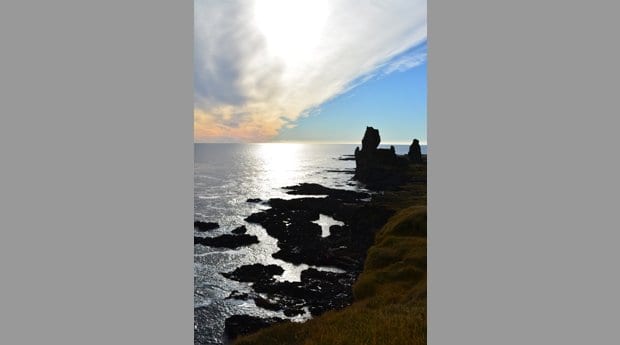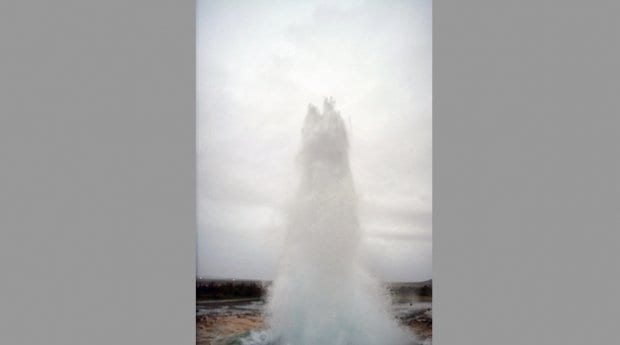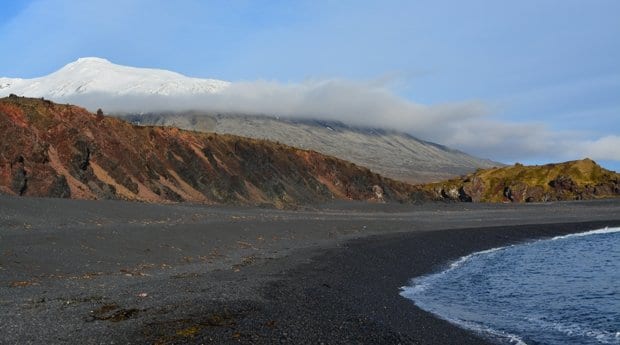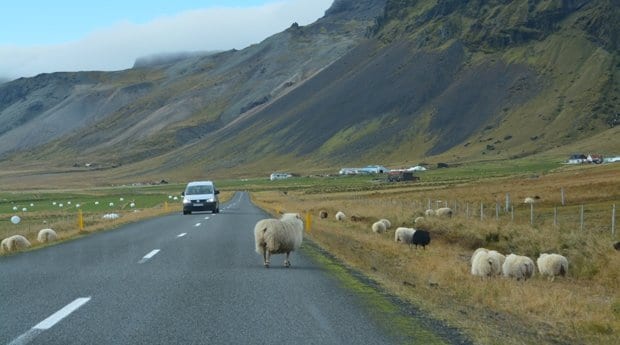
The sun setting over the Snæfellsnes Peninsula lava fields. Credit: Chris Howson

Geyser Strokkur erupts every four to eight minutes, blasting scalding water 40 metres into the air. Credit: Chris Howson

The Atlantic Ocean, a black beach, lava fields and a glacier all in one shot. Only in Iceland! Credit: Chris Howson
You would swear you were heading to colonize Mars circa 2254 upon descending into Iceland. The jagged cliffs, the barren lava fields, the bitter cold — it’s hard to imagine why anyone would want to build a settlement on such an inhospitable island in the middle of the Atlantic Ocean. Yet here we are, touching down for a good old-fashioned gay vacation nearly 1,200 years after the first Norseman made this sub-Arctic Island his home.
Besides being known for Vikings and Björk, Iceland is one of the most socially forward and naturally beautiful countries in the world. Registered partnerships for same-sex couples were introduced in 1996, and 14 years later, in 2010, it became the ninth country in the world to legalize gay marriage.
Iceland broke down more barriers on Feb 1, 2009, when its citizens elected Jóhanna Sigurðardóttir as their prime minister. Not only was Sigurðardóttir the country’s first female prime minister; she was the world’s first openly lesbian head of government. The year after she was elected, Sigurðardóttir married her partner, Jónína Leósdóttir, becoming the first world leader to marry someone of the same gender.
If you are looking for a holiday of binge drinking and all-night partying, Iceland is probably not for you. With a little more than 300,000 citizens, it’s the most sparsely populated country in Europe, so it isn’t surprising that there isn’t a huge gay club scene. That being said, the capital city of Reykjavík does have an LGBT bar: Kiki opened its doors last year in what is referred to as “the queerest corner in Reykjavík’’ and offers drinks and dancing on Friday and Saturday nights.
As you would expect in such a progressive nation, Iceland is not a place you need to hide your sexuality. The majority is in favour of same-sex rights, while most others are stricken with Scandinavian apathy and couldn’t care less about who you are or what your business is.
In the natural course of a nation’s evolution, the rise of socialism and the fall of spirituality tend to go hand in hand. This is not the case in Iceland, where many residents still believe in the existence of fairies, trolls, elves, nymphs, mermaids and myriad other mythological creatures, and it is easy to understand why. Colonized by Vikings, Iceland’s history is richly woven with both documented events and magical fables by the thousands. Building projects are often halted and reassessed to prevent disturbing areas where these creatures are believed to live. Throwing stones is also discouraged, as it is possible to strike and upset one of the huldufólk, or “hidden people.”
This modern-day mythology can be seen by stopping off at any cave, waterfall or glacier, where you can find a brilliant origin story for how the landmark got its name, what events transpired therein and what may or may not still be protecting the area. It is believed that Iceland has maintained this spirituality and interest in the Norse traditions because of centuries of isolation. (The Icelandic language, notably, remains closest to Old Norse of all modern Scandinavian languages.) After travelling around the island for a few days, you may even find yourself believing the old sagas. Seeing garish faces in rock formations, feeling great sensations of tranquility and feeling that you are being watched are not uncommon experiences in the isolated countryside.
As Canadians, it is our inclination to underestimate the physical size of other countries, and although Iceland is tiny by comparison, the 103,000-square-kilometre landmass isn’t exactly walkable. Public transportation is difficult to come by and can waste a great deal of time. Given the well-maintained roads and the fact that Icelanders drive on the right side of the road, renting a car is probably your best option. If you are staying more than three days, drive the spectacular Route One, also known as the Ring Road. It not only passes through Iceland’s largest cities, but takes you within arm’s reach of crater lakes, lava fields, volcanoes, black-sand beaches, thunderous waterfalls, imposing fjords, exploding geysers and some of the world’s largest glaciers. Although the 1,339-kilometre route is a lengthy trek, it provides some of the most breathtaking experiences available on our planet.
If you are planning a shorter visit, limit your drive to the southern portion of the loop; it’s home to Skógafoss, a thunderous waterfall whose spray is said to hide the treasure of the first Viking settler, Þrasi Þórólfsson. Situated next to Skógafoss is Eyjafjallajökull, one of Iceland’s smaller glaciers; Eyjafjallajökull was relatively unknown until the volcano beneath it erupted in 2010, filling the sky with ash and creating the largest air-traffic shutdown since the Second World War, a situation that lasted for two weeks.
Although a scary notion for many, volcanic eruptions are just a part of life for Icelanders. With more than 200 volcanoes spewing out one-third of the world’s supply of lava and 600 hot springs that heat 85 percent of Iceland’s homes, it is one of the most tectonically volatile countries on Earth. It is this geological chaos, however, that has created the stunning and ever-changing landscapes that make this island a little slice of paradise.
Because of its location in the middle of the Atlantic Ocean, Iceland’s only native land mammal is the arctic fox. This makes it an ideal destination for outdoorsmen and hikers since the only angry bear you encounter will be in your party. Much of the breathtaking scenery can be taken in only by hiking, including an unobstructed view of aurora borealis, best viewed in the pitch-black countryside.
The easiest way to explore the country is with Icelandair, an airline specializing in affordable transatlantic trips with free layovers (rather than the exorbitant fees other airlines charge) in their home nation. With 36 destinations on both sides of the Atlantic, the airline makes it simple to add an Icelandic adventure to any European getaway.
And where else in the world can you find men from Wales and Newfoundland on the same Grindr page? That’s a magical experience in itself.
For the most up-to-date travel information on gay Reykjavík, see our City Guide, Listings Guide, Events Guide and Activities Guide.

 Why you can trust Xtra
Why you can trust Xtra